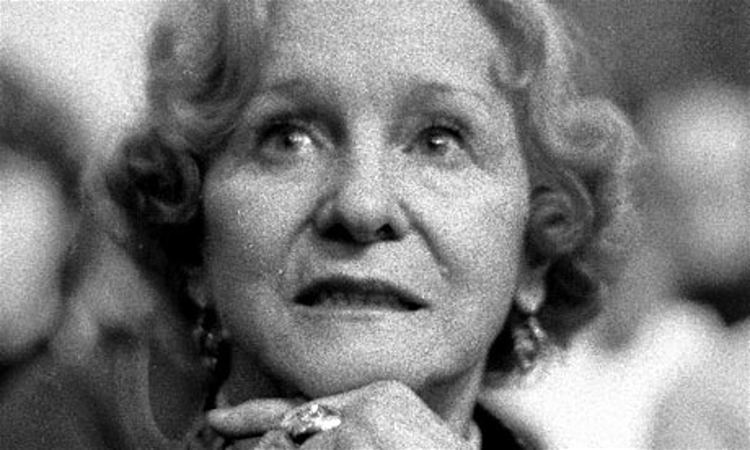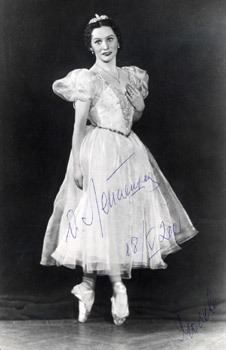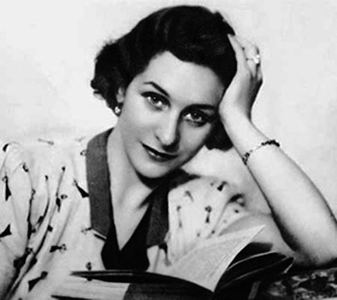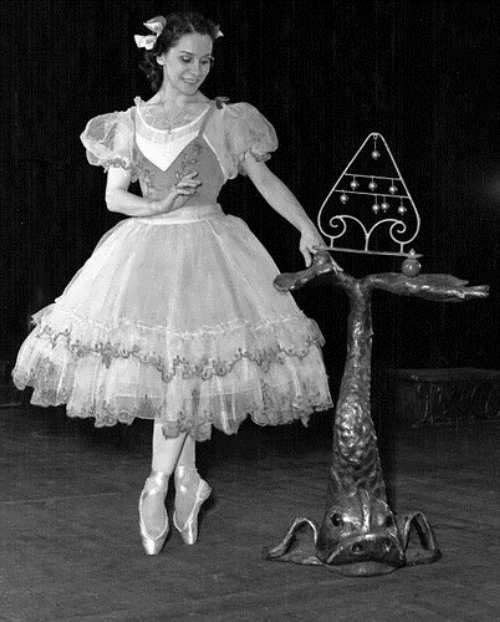Cause of death Heart attack Years active 1935-2008 | Name Olga Lepeshinskaya Role Ballerina | |
 | ||
Occupation Prima ballerina, teacher Died December 20, 2008, Moscow, Russia Parents Vasily Vasilievich Lepeshinsky Similar People Asaf Messerer, Aleksei Antonov, Natalia Bessmertnova, Ekaterina Maximova, Maris Liepa | ||
Olga Vasiliyevna Lepeshinskaya (Russian: Ольга Васильевна Лепешинская; 28 September [O.S. 15 September] 1916 – December 20, 2008) was a Soviet ballerina. She was named a People's Artist of the USSR in 1951.
Contents

Childhood

Lepeshinskaya was born to an old Polish noble family in Kiev, Russian Empire (now the capital of Ukraine). Her grandfather, Vasily Pavlovich Lepeshinsky, was arrested as a member of the revolutionary organization Narodnaya Volya. Her father, Vasily Vasilievich Lepeshinsky, was a railway engineer, one of the builders of the Chinese Eastern Railway.

From the early years Lepeshinskaya showed her talents in dancing and in the 1925 she was admitted to the Bolshoi Choreographic School. She appeared for the first time on the stage of the Bolshoi Theatre at the age of ten as one of the little birds in the ballet The Daughter of the Snows. In 1932 she played the Sugar Plum Fairy in The Nutcracker ballet.
Prima ballerina
Lepeshinskaya graduated from Bolshoi Choreographic School and started working the Bolshoi Theatre. She started as Rosina in a ballet of The Barber of Seville (Тщетная предосторожность) performed by the second stage of the theater. In 1935 she performed the main role in the Three Fat Men ballet by Yury Olesha. The ballet became very popular and the 18-year-old ballerina became famous.

Lepeshinskaya performed in private concerts at the Moscow Kremlin from the age of 17. She was very close to Polina Zhemchuzhina, wife of Vyacheslav Molotov. It was a great shock for her when Zhemchuzhina was imprisoned in a Gulag. Lepeshinskaya was known as the favourite ballerina of Joseph Stalin and even rumoured to be his mistress. In 1943 she became a member of the Communist Party.

Lepeshinskaya married a Soviet intelligence MGB general Leonid Raykhman (known as the handler of Nikolai Ivanovich Kuznetsov). He was arrested on 19 October 1951 as an alleged participant in the fabricated Zionist Plot in MGB. Lepeshinskaya claimed that her appeals to Stalin saved the life of her husband. In March 1953, after Stalin death, Leonid Raykhman was freed, rehabilitated and appointed the head of MVD Control Commission. In August 1953 he was arrested again that time for his own fabrications of criminal cases, tortures of prison inmates and other violations of the "Socialist Law". He was sentenced to five years in prison in August 1956 but amnestied in November 1956. Since then he was doing a research work in astronomy.

In February 1940, the Kirov Ballet in Leningrad first performed their Don Quixote ballet with Lepeshinskaya as Kitry. The ballet was a great success. In 1941, when the Stalin Prize was established, Olga Lepeshinskaya was among the first laureates of the prize for her performance in Don Quixote. Altogether Lepesinskaya received four Stalin Prizes.
With the beginning of the Great Patriotic War Lepeshinskaya became a member of the Front brigade of the Bolshoi Theater. The brigade performed near the front lines, in hospitals, in Moscow and in Saratov where the Bolshoi was evacuated. Lepeshinskaya was a member of the brigade until the end of World War II. Her performances near the battlefields were filmed in the 1941 Soviet Documentary Kontsert - Frontu (Concerto to the Front).
In 1942, the Soviet Youth Anti-Fascist Committee was organized. Lepeshinskaya was its Deputy chairperson.
In 1943, she starred as Assol in the Bolshoi premiere of Scarlet Sails. On May 9 she was with her Bolshoi brigade with Soviet troops in Warsaw. The next day she received her invitation to perform in the Bolshoi's production of Cinderella. The ballet, first performed on 21 November 1945, was the first post-war show at the Bolshoi. Lepeshinskaya won her second Stalin prize for her performance. She received her third Stalin prize for her performance in the Flames of Paris and the fourth prize for the Tao-Hoa role in The Red Poppy. In 1951 she received the People's Artist of the USSR title along with Galina Ulanova.
Teacher
She married Soviet General Aleksei Antonov in 1956. In 1962 her husband died. The nervous shock was so strong that she became temporarily blind. When her vision returned, after a year of treatment, she found herself unneeded by the Bolshoi Theater or the Bolshoi School. Fortunately, she found a place at the Komische Oper Berlin where she worked as a ballet mistress for ten years.
After this she worked as a trainer in many different companies throughout the world. For thirty years she served as the Chairperson of Ballet competitions in Moscow. She was the president of the Russian Choreographic Association (from 1992) and was the Chairperson for the Choreography Entrance Exams at the Russian Academy of Theatre Arts (for her last fifty years).
She helped painter Ilya Glazunov during his early career (she was reprimanded for organizing his first exhibition), so he declared Lepeshinskaya to be his godmother in the art.
Lepeshinskaya died of a heart attack on December 20, 2008 in Moscow at the age of 92.
